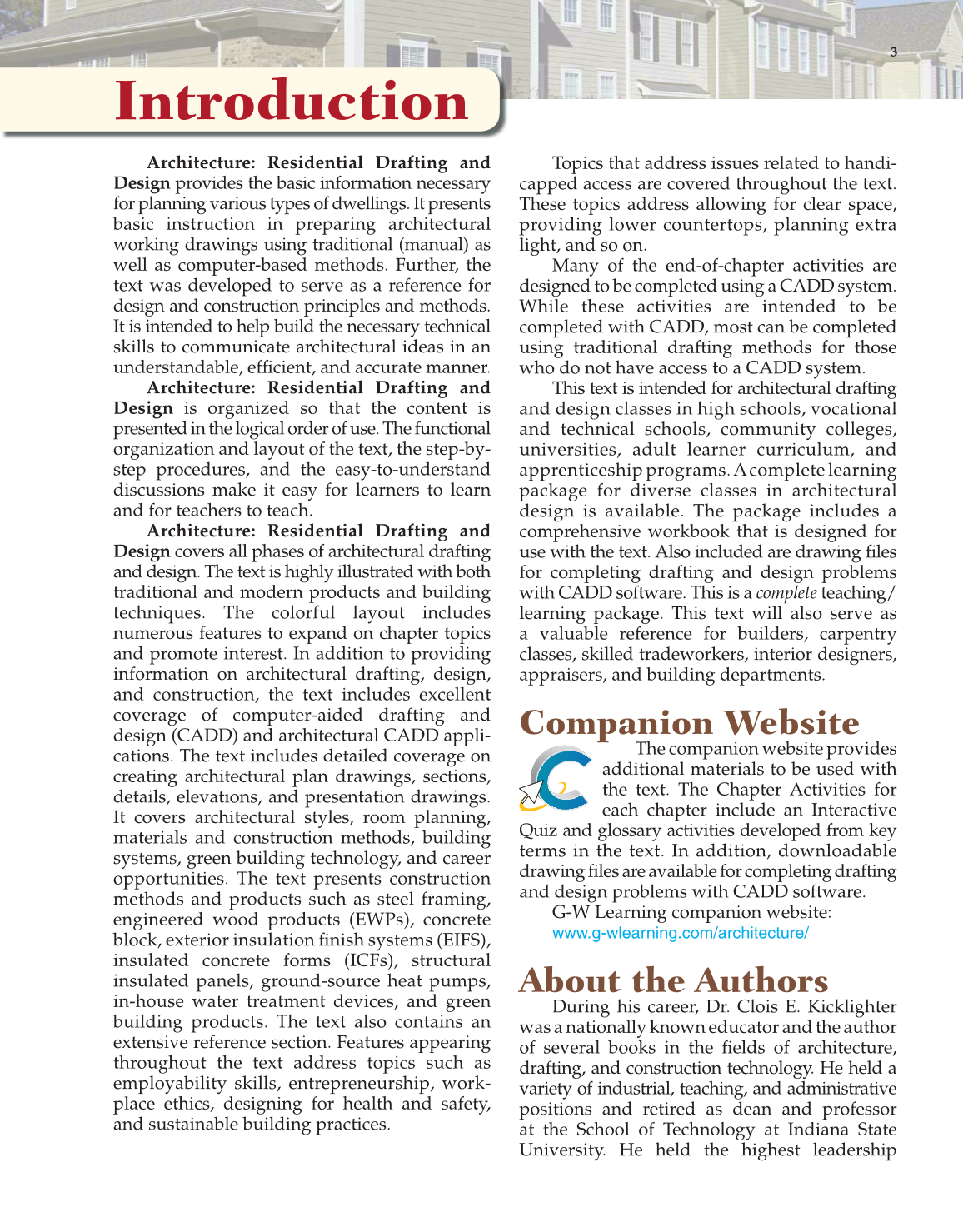3
Topics that address issues related to handi-
capped access are covered throughout the text.
These topics address allowing for clear space,
providing lower countertops, planning extra
light, and so on.
Many of the end-of-chapter activities are
designed to be completed using a CADD system.
While these activities are intended to be
completed with CADD, most can be completed
using traditional drafting methods for those
who do not have access to a CADD system.
This text is intended for architectural drafting
and design classes in high schools, vocational
and technical schools, community colleges,
universities, adult learner curriculum, and
apprenticeship programs. A complete learning
package for diverse classes in architectural
design is available. The package includes a
comprehensive workbook that is designed for
use with the text. Also included are drawing fi les
for completing drafting and design problems
with CADD software. This is a complete teaching/
learning package. This text will also serve as
a valuable reference for builders, carpentry
classes, skilled tradeworkers, interior designers,
appraisers, and building departments.
Companion Website
The companion website provides
additional materials to be used with
the text. The Chapter Activities for
each chapter include an Interactive
Quiz and glossary activities developed from key
terms in the text. In addition, downloadable
drawing fi les are available for completing drafting
and design problems with CADD software.
G-W Learning companion website:
www.g-wlearning.com/architecture/
About the Authors
During his career, Dr. Clois E. Kicklighter
was a nationally known educator and the author
of several books in the fi elds of architecture,
drafting, and construction technology. He held a
variety of industrial, teaching, and administrative
positions and retired as dean and professor
at the School of Technology at Indiana State
University. He held the highest leadership
Architecture: Residential Drafting and
Design provides the basic information necessary
for planning various types of dwellings. It presents
basic instruction in preparing architectural
working drawings using traditional (manual) as
well as computer-based methods. Further, the
text was developed to serve as a reference for
design and construction principles and methods.
It is intended to help build the necessary technical
skills to communicate architectural ideas in an
understandable, effi cient, and accurate manner.
Architecture: Residential Drafting and
Design is organized so that the content is
presented in the logical order of use. The functional
organization and layout of the text, the step-by-
step procedures, and the easy-to-understand
discussions make it easy for learners to learn
and for teachers to teach.
Architecture: Residential Drafting and
Design covers all phases of architectural drafting
and design. The text is highly illustrated with both
traditional and modern products and building
techniques. The colorful layout includes
numerous features to expand on chapter topics
and promote interest. In addition to providing
information on architectural drafting, design,
and construction, the text includes excellent
coverage of computer-aided drafting and
design (CADD) and architectural CADD appli-
cations. The text includes detailed coverage on
creating architectural plan drawings, sections,
details, elevations, and presentation drawings.
It covers architectural styles, room planning,
materials and construction methods, building
systems, green building technology, and career
opportunities. The text presents construction
methods and products such as steel framing,
engineered wood products (EWPs), concrete
block, exterior insulation fi nish systems (EIFS),
insulated concrete forms (ICFs), structural
insulated panels, ground-source heat pumps,
in-house water treatment devices, and green
building products. The text also contains an
extensive reference section. Features appearing
throughout the text address topics such as
employability skills, entrepreneurship, work-
place ethics, designing for health and safety,
and sustainable building practices.
Introduction
